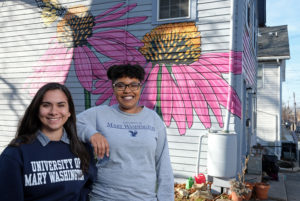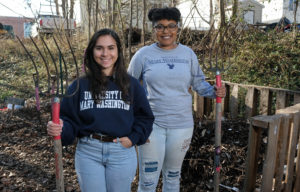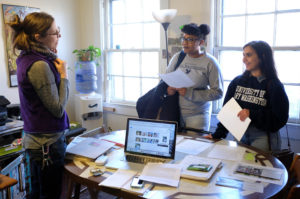The screen showed mounds and mounds of perfectly good bread from bakeries in Europe – tossed out because of the countries’ regulations. In fact, according to the Food and Agriculture Association of the United Nations, 1.3 billion tons of food is wasted each year.

The video, part of a course called Food Justice, got UMW juniors and best friends Jasmine Pope and Tirzah Rao thinking. What happens to leftover food at restaurants around Fredericksburg? For their final project in the class, taught by Professor of Sociology Tracy Citeroni, the students decided to find out. They spent their fall semester interviewing restaurant owners, but the results weren’t what they’d expected.
They found that restaurants downtown didn’t have large amounts of waste like they’d seen in the film, but the pair is committed to finding ways to repurpose what leftovers there are. Rao hopes to connect the establishments with food recovery programs, which collect surplus edibles from restaurants, grocery stores and farmer’s markets for distribution among emergency food banks and shelters. Pope wants to come up with a plan to recycle food waste into sustainable energy or compost.
“I’m thrilled about their dedication to and enthusiasm for this issue and look forward to seeing how their research develops,” said Citeroni, who points to Pope and Rao as the first to focus on the issue of food waste in the Fredericksburg community since she created the Food Justice course in 2010.

The class aims to teach students how politics, the economy and culture play a role in how we produce, distribute and consume food in America, and how the food industry can be re-evaluated to accommodate everyone. At the very least, Citeroni hopes the course gets students excited enough to think about how they can advocate for alternative policies.
It has.
“Students get involved in ongoing food justice initiatives,” she said, “and create an action plan to further those goals through their own research.”
Many have created action plans to address issues such as poverty, school nutrition, farmland restoration and more.
Pope and Rao asked managers of expensive, inexpensive and moderately priced restaurants like Jay’s Downtown Sports Lounge if they participated in food recovery programs – and if they even knew what that meant. The students asked each establishment how much and what types of food waste it produced, and where the waste ended up.

Pope and Rao found that downtown Fredericksburg restaurants vary in the types and quantities of food they end up losing, and that most were unaware of nearby food recovery programs, defined by the Environmental Protection Agency as industrial, humanitarian and environmental.
The pair hopes to find a way to help restaurants begin systems of food recovery, such as taking waste to organizations like Downtown Greens – a non-profit green space in the city that promotes environmental care and sustainable gardening methods – for composting.
“Society focuses on feeding the hungry and people in need, but food spoils and there’s nothing you can do to help that,” Pope said. “So, in the case that it does spoil, [we should find] a way to still use that food source.”